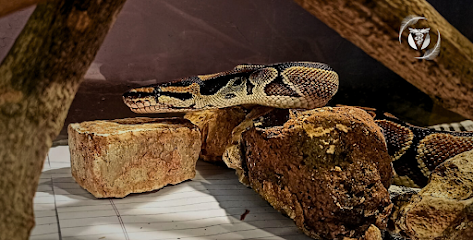The Herp Index: How Do Pythons Eat?
Their feeding process is a remarkable display of evolutionary adaptation involving sensory detection, muscular control, skeletal flexibility, and biochemical efficiency.
Let’s dive into the detailed mechanism of how constrictor snakes eat, step by step, including the underlying biology.
1. Sensing and Locating Prey
 |
| ~ Difference in location of nostrils and heat pits ~ |
Constrictors
rely on a combination of olfaction, vibration sensing, vision,
and, in some species, infrared heat detection to locate prey.
- Olfaction (smell): The forked tongue collects
scent particles and transfers them to the Jacobson’s organ
(vomeronasal organ) in the roof of the mouth, where chemical signals are
analyzed.
- Heat sensing: Boas and pythons possess heat-sensing
pits along the lips that detect the body heat of warm-blooded prey,
allowing them to “see” thermal images even in darkness.
- Vibrations: Sensitive to ground
vibrations, constrictors can detect movements of nearby animals.
These sensory tools help the snake decide when and where to strike.
2. The Strike
- The snake opens its jaws and grabs the prey with recurved teeth that point backwards, preventing escape.
- The speed of the strike is powered by coiled muscles, with reaction times measured in fractions of a second.
3. Constriction: The Killing Mechanism
Immediately after the bite, the snake wraps its coils tightly around the prey’s body. Constriction is not about crushing bones — the actual mechanism is more sophisticated.
- Constriction does not suffocate prey as previously believed. Instead, it causes circulatory arrest.
- Studies have shown that constriction cuts off blood flow to the brain, causing unconsciousness in seconds.
- Each time the prey exhales, the snake tightens its coils further, preventing reinflation of the lungs and reducing oxygen supply.
- The rapid loss of oxygen and drop in blood pressure induce cardiac arrest. The animal passes away in less than a minute.
Constriction is a precise, energy-efficient killing method that minimizes risk to the snake.
4. Aligning and Swallowing Prey Whole
Once the prey is dead, the snake begins the process of ingestion.
 |
| ~ Locating the head ~ |
- The snake locates the head of the prey and starts swallowing from that end to fold limbs and fur in the direction of movement.
 |
| ~ Important anatomical structures in a snake jaw ~ |
- Quadrate bones act as hinges, allowing the jaws to open up to 150° or more.
- The lower jawbones (mandibles) are not fused and are connected by the elastic ligament, enabling them to spread apart and engulf large prey.
- Muscles and ligaments allow each side of the jaw to move independently — a technique called “pterygoid walking.”
- Backward-facing teeth grip the prey and help pull it inward while preventing escape.
This phase may take several minutes to hours, depending on the size of the meal.
5. Digestive Overdrive
After ingestion, the real work begins: digestion. Snakes have evolved to process massive meals with remarkable efficiency.
- The snake’s metabolism shifts into overdrive, increasing oxygen consumption by 10–44 times the resting rate.
- Stomach acid reaches a pH close to 1, dissolving bones, fur, feathers, and flesh.
- Digestive enzymes break down proteins, fats, and minerals, starting in the stomach and continuing in the small intestines.
Depending on the prey size, this high-energy process can last days to weeks. During this period, the snake becomes lethargic and vulnerable.
6. Waste Elimination
After digestion:
- Indigestible materials, such as large bones or fur, are compacted and passed as waste through the cloaca.
- The snake then enters a rest phase, often not eating again for days, sometimes weeks.
This slow feeding cycle is an energy-efficient strategy that allows constrictors to survive on fewer meals, a crucial trait in ecosystems where food is unpredictable.
That's all, folks.
I will be posting more articles covering rehabilitation, enclosures, diet, free flight, and training with species like turtles, snakes, dogs, and more.
- Gmail - namratansahoo@gmail.com
- Instagram - @TheVetDiariesBlog








.jpg)





Comments
Post a Comment